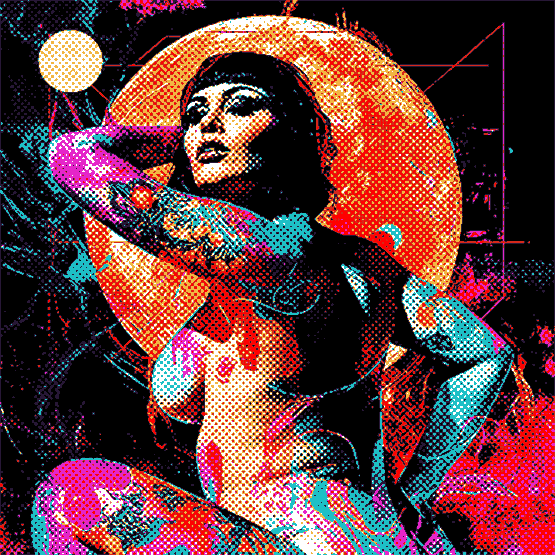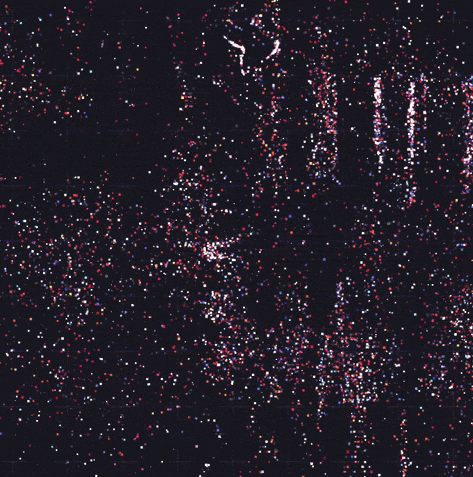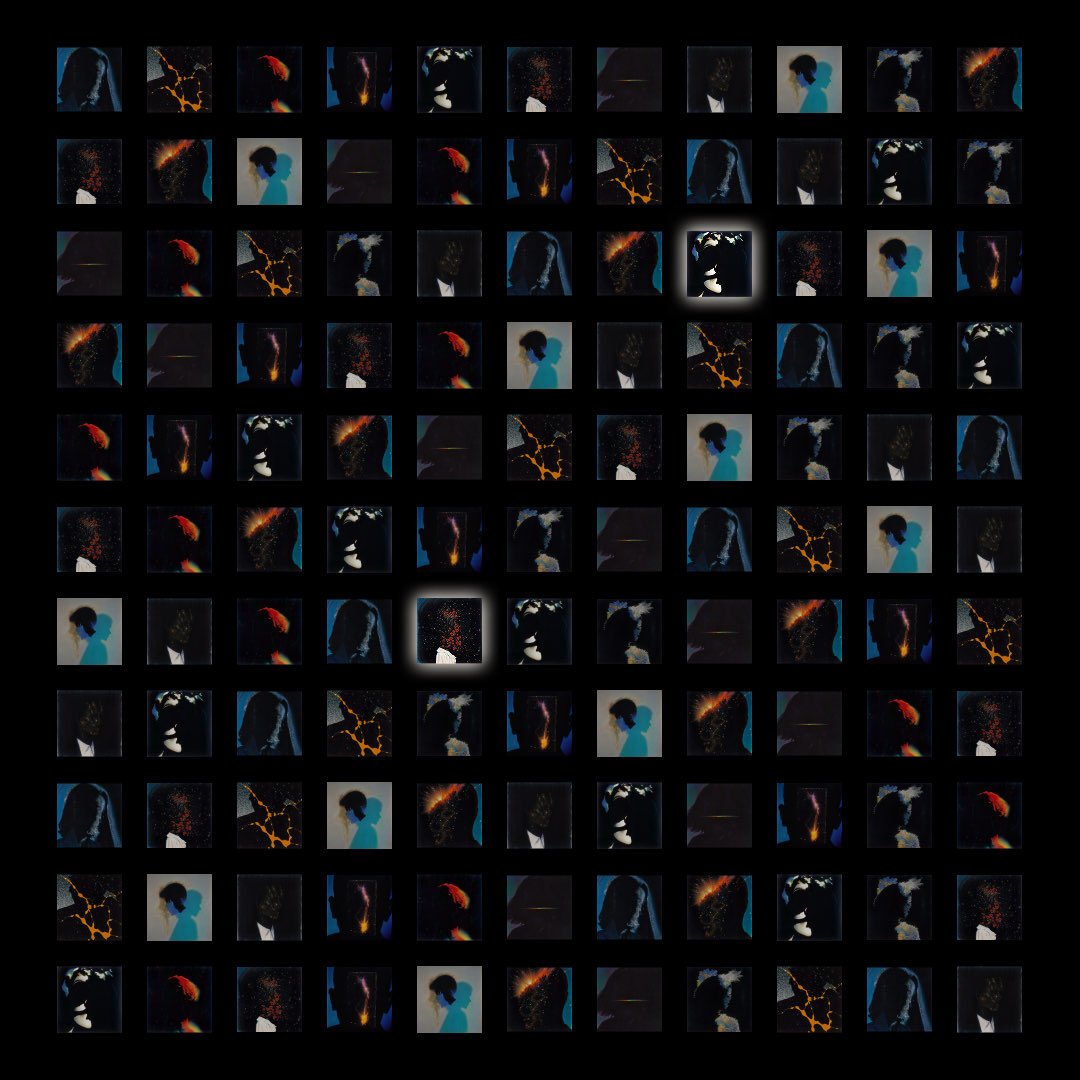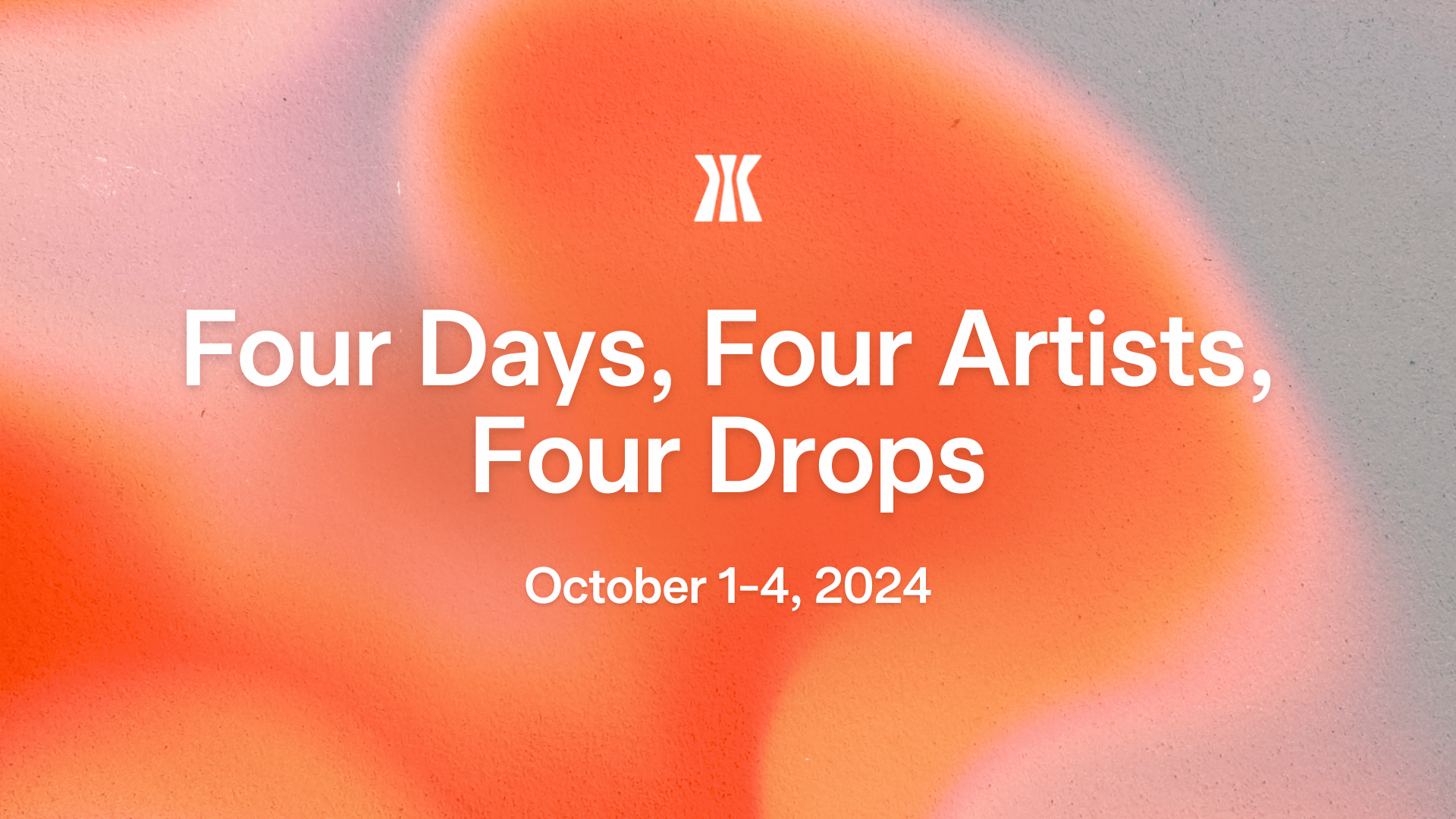In a world obsessed with perfection, glitch art stands out by celebrating the beauty of errors. Early pioneers like Nam June Paik and Steina and Woody Vasulka used video synthesizers to explore the creative potential of electronic glitches. Later, artists like Rosa Menkman and JODI pushed the boundaries further, turning corrupted files and pixelated images into striking visual statements. All using digital “mistakes” to create eye-catching artworks.
Glitch art reflects the fragility and unpredictability of the digital age, challenging our perceptions of beauty and technology. In this blog we meet five Gamma Partner Artists further exploring glitch and its capabilities.

One such artist is Gamma Partner Artist Empress Trash. Her journey into glitch art is rooted in a lifelong fascination with systems and a curiosity that led to exploring the unexpected.
From a young age, Empress Trash found herself captivated by the systems around her. Growing up, she often felt lonely and had to entertain herself in various ways. This led to a natural curiosity that sometimes resulted in breaking things. One of her earliest fascinations was with her Teddy Ruxpin, the singing bear. She would record songs off the radio and play them through the bear, finding it amusing to hear different voices. This early experimentation with manipulating systems laid the foundation for her later work in glitch art.
Her interest in systems extended to other areas as well. She would create rivulets in mud puddles, study maps, and stare at the snow on the TV, imagining scenes within the static. These moments of creative play and exploration gradually accumulated, leading her to embrace glitch art as a medium.
When she eventually got her own computer, Empress Trash began creating digital art by scanning her drawings and manipulating them in Photoshop. At the time, she didn’t consider it to be fine art—digital art wasn’t mainstream during her high school years. While her formal art education focused on traditional media, with digital work as a side interest, she began to blend digital and traditional techniques more seriously during college. Despite criticism from some who viewed her pursuit of art as a waste of time, it was never a waste to her. Art was the driving force in her life, and glitch art became a way to channel her innate destructive tendencies.
Empress Trash's fascination with natural variations and deviations—like DNA, or how water and wind erode landscapes—deeply influences her work. To her, the universe is a dance of chaos, where life emerges from the unexpected. While society often seeks perfection, she sees this as an illusion. Nature’s cycles, with their inherent glitches, dictate life, and her work taps into this unpredictability.
Rather than trying to balance the chaos in her art, she embraces it fully, making it palatable for others to digest. She prefers to slow down her glitches, creating a smoother transition into the subconscious mind without triggering defense mechanisms. By juxtaposing still elements with animated ones, she creates visual friction that highlights the chaos rather than balancing it. To her, it's like placing complementary colors side by side—each element enhances the other’s vibrancy.
For Empress Trash, glitches are not flaws but "happy little accidents" that open up new possibilities. She recognizes that by embracing what others might view as mistakes, she can discover new aesthetics and visual languages that might otherwise remain unexplored. This perspective drives her creative process, allowing her to push boundaries and find beauty in the unexpected.
Her approach to glitch art goes beyond the visual. Systemically, her work often finds and exploits glitches within societal structures. For example, in a recent piece with Superchief, she self-censored her work to comply with standards, creating a commentary on censorship. By adhering to the rules while simultaneously pushing against them, she crafted a piece that exists at the boundary of systemic compliance and non-compliance, embodying a quantum state of being both in and out of the system.
Empress Trash's work is underpinned by a deep interest in psychology, intersectional feminism, religion, science, and politics. She studies propaganda and the subconscious effects of media, which she seeks to disrupt in her art. Her glitch art attempts to overload the programming of mainstream media, creating loops that catch attention while offering depth for those who choose to meditate on the work. In a world where constant scrolling is detrimental to mental health, she aims to disrupt this cycle and guide viewers toward more mindful engagement.
Collaboration has also played a significant role in shaping Empress Trash’s approach to glitch art. Over the years, she has worked with a wide range of artists and technologists, each interaction informing her work in different ways. These collaborations have contributed to the development of her unique style, blending influences into the cohesive yet chaotic aesthetic that defines her work.
Emerging technologies, particularly AI, have also caught Empress Trash’s interest. She sees AI as a tool that taps into a collective visual consciousness, where mistakes and unexpected outcomes are inherent. For her, AI is a disruptive technology that highlights the flaws in our systems, sparking important conversations about humanity's relationship with technology. She is drawn to AI for its ability to reveal truths about society that many prefer to ignore.
In embracing the chaos and unpredictability of glitches, Empress Trash challenges our perceptions of art and technology, encouraging us to see the beauty in imperfection. Through her work, she invites us to explore the unexpected and find new ways to engage with the digital world.

Gamma Partner Artist Krrowbar who describes his work as producing "tainted visions through the frozen image." This artist's journey into glitch art began with the discovery of Xcopy's work, which sparked his interest in the genre. Since then, he has sought to incorporate glitch elements into each of his creations, blending the unique aspects of glitch art with the raw energy of Basquiat. This fusion creates a powerful visual language that defines his artistic voice.
In discussing his creative process, the artist emphasizes that there are no specific provisions or definite steps. His approach is spontaneous, aiming to offer a different atmosphere from other artists. He draws inspiration from a range of sources, including artists like King-Xerox, Mex.TEXT, Disaster, and Scapegrace. The tone of his colors is a signature element, making his work instantly recognizable.
For this artist, glitches serve as both artistic opportunities and technical flaws. He acknowledges that glitch art has evolved into a recognized and celebrated art form, no longer confined to the effect cuts in films or video openings. The rise of glitches as a trend in the art industry has further motivated him to explore his work, pushing the boundaries of what glitch art can be.
His conceptualization of glitch and error is rooted in spontaneity. He rarely starts with a sketch; instead, he expresses snippets of sentences or raw ideas directly onto a blank canvas. The process involves layering strokes, erasing, and adding small elements to support the overall composition. This method allows him to embrace the richness of lived experiences, leading to genuine and compelling creative outcomes.
While this artist has yet to collaborate with other artists or technologists, he acknowledges the potential influence of emerging technologies like AI on glitch art. However, he prefers to keep his work natural, despite its limitations, and has not felt the need to integrate AI into his process so far.
In embracing both the flaws and opportunities presented by glitches, this artist continues to develop his unique voice within the glitch art genre, offering tainted visions that challenge and captivate the viewer.

Another Gamma Partner Artist making waves in the glitch art scene is cvr. Her journey into glitch art began with a simple animation on her iPad, where a leaf blowing in the wind opened up a new world of creative expression. This experience was further solidified when she discovered "All Time High in the City" by Xcopy, a piece that left a lasting impact on her.
To cvr, glitch art is not just about visual aesthetics; it creates and enhances powerful visuals that resonate deeply with her as an artist.
One of the unique challenges she faces with ordinals is the need for smaller file sizes, which often leads to unexpected "errors" like textured grain and unusual layer patterns. Instead of seeing these as limitations, cvr embraces them as opportunities to push her artistic boundaries. This approach is a testament to her belief that the inherent randomness of glitches can be harmonized with a clear artistic vision, provided the artist stays true to what they intrinsically connect with.
For cvr, glitches are far from technical flaws—they are artistic opportunities that drive her creative process. She sees the creative journey as a means for emotional and spiritual growth, where every glitch, every error, is a step closer to deeper connection and expression. Inspired by the work of Xcopy, she has come to see the depth and fullness of what she can conceptualize, with glitches helping her to communicate the complexity of her emotions and thoughts.
Philosophically, cvr’s work is rooted in the human experience. Her collaborations with other artists and technologists have taught her to be a better student of her craft, reminding her that not all errors can—or should—be controlled. This willingness to embrace the unpredictable is a key aspect of her approach to glitch art.
When it comes to emerging technologies like AI, cvr is open to their influence but maintains a balanced perspective. She appreciates the skill required to use AI effectively, seeing it as a craft in its own right. Rather than allowing AI to dominate her work, she prefers to use it in partnership with glitch art, enhancing rather than overshadowing the unique qualities that make her art so rare. As she continues to explore these tools, cvr remains committed to the process, always looking for new ways to engage with her evolving medium.

Jak, another Gamma Partner Artist, has a unique approach to glitch art that is rooted in both spontaneity and personal expression. He was initially drawn to glitch art simply because he thought it "looked cool" and felt it would be fun to try. What started as a playful experiment quickly became a primary form of artistic expression for him.
The influence of 90s television static played a key role in Jak's creative process, inspiring his piece "More Noise." He embraces randomness in his work, explaining that his process is inherently unstructured. Rather than having a clear artistic vision or aiming for balance, Jak allows his work to evolve organically, often integrating glitches as both artistic opportunities and technical flaws. Sometimes, the glitch itself becomes the art, while other times he adds glitch elements to pre-existing pieces, reflecting his flexible, exploratory approach.
When it comes to the philosophy behind his work, Jak doesn't claim any grand conceptual ideas underpinning his use of glitches. However, he views glitch as a form of rebellion, comparing it to graffiti. It's an expression of his experience, unbound by rigid structures or rules. Collaboration with other artists has deepened his appreciation for different techniques and cultures, opening him up to new ideas and processes, further enriching his artistic practice.
Regarding emerging technologies like AI, Jak sees them as a positive force, adding that "more tools is good." His desire to play, express himself, and grow as an artist motivates him to explore these new tools, reflecting his open-minded and evolving approach to glitch art.

Last but not least, Sir Gadfly, another prominent Gamma Partner Artist working with glitch art, approaches the medium with a storyteller’s mindset. For him, glitch art represents the shortest form possible to convey and evoke deep meaning in life. Storytelling is the foundation of his creative world, typically expressed in long form. However, glitch art challenges him to "pack a punch" in a much more concise, impactful way.
One of Sir Gadfly's favorite techniques is the RGB split shift, a tool from the Boris Sapphire toolkit. This technique allows for a color shift split that creates dynamic movement within his pieces, resulting in vibrant and enriching visuals. Movement is central to his artistic philosophy, as he sees chaos as the core of life itself—static is synonymous with death.
Glitches, in Sir Gadfly’s view, are both artistic opportunities and technical flaws. He embraces the beauty in chaos, recognizing that errors and flaws are tools to be harnessed creatively. His process doesn’t begin with the glitch itself but rather with the story he wants to tell. For him, the glitch is like the "lipstick for the masterpiece," an embellishment that enhances the narrative he aims to communicate.
Philosophically, Sir Gadfly draws inspiration from thinkers like Socrates and Timothy Leary, believing that thoughts are powerful and that life must be questioned and examined. His name, a reference to Socrates, underscores his commitment to these ideals. Glitch art, for him, is a medium through which he can tell short, impactful stories, each piece serving as a small yet profound examination of life.
While Sir Gadfly has yet to fully delve into collaborations with other artists or technologists, he sees these interactions as a potential avenue for further exploration. His approach to emerging technologies, including AI, is pragmatic; he views them as tools, much like the dozens he already uses for storyboarding, creation, and compression. His mantra remains clear and consistent: "Go forth and glitch. Make art, not war." Through his work, Sir Gadfly continues to explore the intersection of chaos, beauty, and storytelling, using glitch art as his medium of choice.
Dive into Glitch Prints on Gamma




